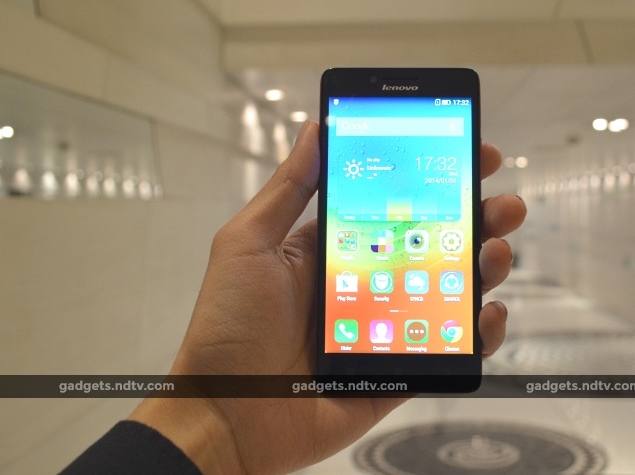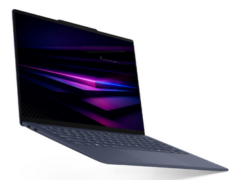- Home
- Mobiles
- Mobiles Reviews
- Lenovo A6000 Ready to Take On Micromax's Yu Yureka and Xiaomi Redmi Note 4G
Lenovo A6000 Ready to Take On Micromax's Yu Yureka and Xiaomi Redmi Note 4G

Lenovo has partnered with Flipkart to sell the device through flash sales, just like Xiaomi and Yu have done so. Registrations started on Friday at 6pm IST and will remain open until 6pm on January 27. The actual sale will commence on January 28 at 2pm IST for registered customers, though the company hasn't said how many units will be available.
Starting with the design, the Lenovo A6000 very much resembles Xiaomi's Redmi Note at first glance, but it is little sleeker at 8.2mm thick as opposed to 9.5mm. However the A6000 is a lot lighter, weighing 128 grams, whereas the Xiaomi Redmi Note weighs 199 grams.
(Also see: Lenovo A6000 vs. Xiaomi Redmi Note 4G)
The Lenovo A6000 smartphone feels sturdy in hand. The rear panel has a matte finish which is a plus for the phone as it attracts fewer fingerprints and is less likely to slip out of a hand. Notably, the Yu Yureka's rear panel has a similar matte finish, which is more inspired by the OnePlus One's rear.
Up front, the Lenovo A6000 features a 5-inch HD (720x1280-pixel) IPS screen, which is smaller than the 5.5-inch screen on both Micromax's Yu Yureka and Xiaomi's Redmi Note. We only tested the device indoors, but we can say that the screen appeared bright and evenly lit. Viewing angles at full brightness didn't appear to be a problem, though legibility outdoors under sunlight remains to be seen.
One of the highlights of the device is its Dolby Digital Plus-certified dual speakers. Unfortunately we couldn't test sound output as the phone had no preloaded media.
The A6000 is powered by a 64-bit quad-core Qualcomm Snapdragon 410 (MSM8916) SoC clocked at 1.2GHz, coupled with 1GB of RAM. It runs Android 4.4 KitKat with Lenovo's Vibe UI 2.0 skin on top. Lenovo says it will release an update to Android 5.0 Lollipop, but no timeframe was announced.
After our limited time using the A6000 smartphone, we believe it should do a fair job in terms of day-to-day usage, though we will grill it thoroughly in our formal review before delivering a verdict.
(Also see: Lenovo A6000 vs. Micromax's Yu Yureka)
The Lenovo A6000 has an 8-megapixel autofocus rear camera with LED flash, and a 2-megapixel front camera. Indoor image quality using the rear camera without flash appeared average to us. The Redmi Note has a 13-megapixel camera, and so the A6000 seems lacking on that front.
The smartphone is powered by a 2,300mAh removable battery rated to deliver up to 13 hours of talk time and up to 264 hours of standby time on 3G networks. The phone also supports 4G LTE, including both bands used in India: FDD 1800MHz (Band 3) & TDD 2300MHz (Band 40).
Our first impressions of the Lenovo A6000 in the limited time we spent with it is that this phone appears very promising. Consumers might have a hard time purchasing the device, as we have seen with the popular yet controversial Xiaomi and Yu flash sales including the most recent one earlier this week.
(Also see: Lenovo A6000 vs. Micromax's Yu Yureka vs. Xiaomi Redmi Note 4G)
We will soon review the device and deliver a final verdict. Do stay tuned, and in the meanwhile you can check out our full review of Micromax's Yu Yureka, the Xiaomi Redmi Note 3G, and the Redmi Note 4G.
Catch the latest from the Consumer Electronics Show on Gadgets 360, at our CES 2026 hub.
Related Stories
- Samsung Galaxy Unpacked 2025
- ChatGPT
- Redmi Note 14 Pro+
- iPhone 16
- Apple Vision Pro
- Oneplus 12
- OnePlus Nord CE 3 Lite 5G
- iPhone 13
- Xiaomi 14 Pro
- Oppo Find N3
- Tecno Spark Go (2023)
- Realme V30
- Best Phones Under 25000
- Samsung Galaxy S24 Series
- Cryptocurrency
- iQoo 12
- Samsung Galaxy S24 Ultra
- Giottus
- Samsung Galaxy Z Flip 5
- Apple 'Scary Fast'
- Housefull 5
- GoPro Hero 12 Black Review
- Invincible Season 2
- JioGlass
- HD Ready TV
- Laptop Under 50000
- Smartwatch Under 10000
- Latest Mobile Phones
- Compare Phones
- Motorola Signature
- Vivo Y50e 5G
- Vivo Y50s 5G
- Realme 16 Pro+ 5G
- Realme 16 Pro 5G
- TCL Nxtpaper 70 Pro
- OPPO A6 Pro 5G
- Honor Power 2
- Lenovo Yoga Slim 7x (2025)
- Lenovo Yoga Slim 7a
- Realme Pad 3
- OPPO Pad Air 5
- Xiaomi Watch 5
- Huawei Watch 10th Anniversary Edition
- Acerpure Nitro Z Series 100-inch QLED TV
- Samsung 43 Inch LED Ultra HD (4K) Smart TV (UA43UE81AFULXL)
- Asus ROG Ally
- Nintendo Switch Lite
- Haier 1.6 Ton 5 Star Inverter Split AC (HSU19G-MZAID5BN-INV)
- Haier 1.6 Ton 5 Star Inverter Split AC (HSU19G-MZAIM5BN-INV)


















